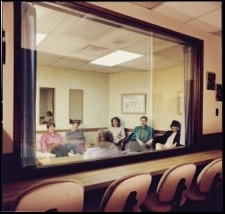“Why do large companies fail to innovate?” This a question I addressed in an interview with BFM, a French-speaking Business radio show. I was invited on L’Atelier Numérique, a show dedicated to innovation. More here.

François Sorel: Hello, welcome to L’Atelier Numérique, the high-tech workshop. Thanks for being with us. Let’s start with “blogonaute”, our blog meeting. We read through all innovation blogs on a weekly basis. We select one article that we really like and invite the author to talk about it.
I/ Succeeding at innovation remains challenging for large companies
Mathilde Cristiani: Indeed, today we’ll be talking to the author of not one post but four posts ! The post has three different parts and a fourth one will be published soon. The post is entitled: “succeeding at innovation remains a challenge for large companies”. It was written by Guillaume Villon de Benveniste. He’s an innovation consultant and he writes on TheInnovationAndStrategyBlog.com. Hello Guillaume!
Guillaume Villon de Benveniste : Hello !
Mathilde Cristiani (MC): in the post, you mention that many companies develop innovations that are later retired from the market because they have failed to find consumers. You add that large companies provide incorrect reasons for why they struggle at innovation.
Guillaume Villon de Benveniste (GVdeB) : That’s correct.
MC: So why do large companies struggle with innovation?
GVdeB : There are multiple reasons. Sometimes companies blame circumstances: the product didn’t do it, or the market wasn’t there. But I believe that the real reason is of a very different nature. If companies fail to innovate, it is because they don’t know how to innovate. And they don’t know how to innovate because they rely way too much on consumer testing*. And, consumer testing is not the right way of innovating. That’s my point of view.
II/ Why is consumer testing not relevant for innovation?
MC: So why is consumer testing not the right way of innovating? Is it because it doesn’t provide a sense of future trends?
GVdeB: Yes that’s one reason. In fact, it’s quite simple. It takes time to do consumer testing, between six months to one year. And then it takes another year to develop the product. So it takes a total of two years to launch an innovation on the market. And by the time the product is finally launched, it’s already out of date. Obviously, this doesn’t help innovation.
MC: So, you believe that large companies should basically avoid consumer testing. But isn’t it very important to get the consumer’s point of view when innovating?
GVdeB: Yes, and large companies should involve consumers in innovation in a different way. Would you want me to tell you more about why consumer testing isn’t efficient at innovation or would you want me to tell you about how large organizations should involve consumers in innovation?
MC: I’d like to know more about both!
GVdeB: well, the other reason why consumer testing isn’t efficient at innovating is of cognitive nature. When large companies ask consumers what they want, consumers have a difficult time imagining new ways of using a product that they use on a daily basis. This is called functional fixedness and has been tested many times in cognitive psychology.
MC: Yes
GVdeB: That’s why consumer testing doesn’t work. Consumers don’t have innovation ideas because they have this cognitive bias which prevents them from formalizing innovation ideas.

François Sorel: Could you give us an example of functional fixedness?
GVdeB: Sure! Assume there’s a nail sticking out from a board. You have a brick nearby. You could use the brick to hammer in the nail, but due to functional fixedness, you do not realize the brick can be used for this purpose. So, you run around searching for a hammer.
François Sorel: Okay. So, how does this apply to innovation?
GVdeB: Well, when a car driver is asked for innovation ideas for his car, he can’t think of anything else than ideas that would improve his driving experience. For example, a few years ago I was a sales manager in the United States and I was in charge of creating a US office for a French consulting firm in New York. I would spend between 3 to 4 hours in my car going from one client meeting to another. Had I been asked how to improve my car, I would have suggested: “make the engine more powerful and improve security!”.
MC: Yes
GVdeB: But in fact, in my car, I would spend most of my time answering the phone, writing emails, and typing on my computer’s keyboard while I was waiting for the red traffic light to turn green. In other words, I used my car, not so much as a means to get around, but as a mobile office. There’s a mismatch between what consumers say they want (“a more powerful engine”) and what they really need, given the way they use a given product.

Courtesy of Mobile Wireless Solutions
MC: And that’s what brands must learn?
III/ A successful innovation makes life easier
GVdeB: Absolutely! They must not rely upon what consumers say they want and focus more on how their consumers are using their products, given the tasks that they are trying to get done. They should identify the different tasks that their consumers are trying to accomplish on a daily basis, like “getting work done in my car”, for example. And, they should develop products that makes these tasks easier to accomplish.
In the case of the car being used as a mobile office, innovations ought to make it easier to work in one’s car. Such innovations may include:
- an integrated wifi system for better email communication
- an onboard printer for last minute proposal printing
- an onboard computer power plug
- a place to securely fasten the computer to keep the computer in a safe place despite a sometimes rocky ride
If companies are able to develop a product that makes these tasks easier to accomplish, then they will be assured to have a market. Consumers will flock to this innovation product because it makes their lives easier. A successful innovation makes consumer life easier.
MC: And that’s how company will reach their innovation goals! Thank you very much Guillaume! Please check out the post published on TheInnovationAndStrategyBlog.com. The post is entitled: succeeding at innovation remains a challenge for large organizations. Thanks again!
GVdeB: Thank you very much!
François Sorel: Thank you very much!
*please be informed that the term “consumer testing” refers to several components:
- It’s defined as testing new products with consumers in order to get their input and change the product accordingly.
- In this post, the term also refers to focus groups which are used prior to developing an innovation product. It’s during focus groups aimed at creating a product concept that functional fixedness is most prevalent.
Further resources:
- Want to listen to the real thing? Download the MP3 audio file here; alternatively, listen to the podcast on the radio’s website.
- For examples of functional fixedness, please refer to this image showing how sunglasses can be used as a rear-view mirror, to this image showing how a fan can be used as leaf-blower and to this image showing how beer boxes can be used at a TV set. Finally, please refer to the candle problem, as described here, to get a more comprehensive understanding of functional fixedness. For examples of how to overcome functional fixedness, please refer improvisation games, including the object game described here and enacted here.
- For a discussion on how functional fixedness may be detrimental to consumer testing and to the innovation process as a whole, please refer to this post.
[…] ce qu’ils font effectivement, il y a parfois une différence, comme l’atteste l’exemple du commercial en […]
[…] a presentation of the jobs-to-get done approach, please refer to this post on the TheInnovationAndStrategyBlog; alternatively, please refer to Anthony Ulwick’s […]
[…] For a discussion on why large companies fail to innovate, please refer here […]
[…] For a discussion on why large companies fail to innovate, please refer here […]
[…] For a discussion on the drawbacks of customer focus groups, please refer here […]
[…] has helped Inova, an innovation software company, improve its product portfolio by applying the “jobs-to-be done” innovation approach, resulting in new client […]